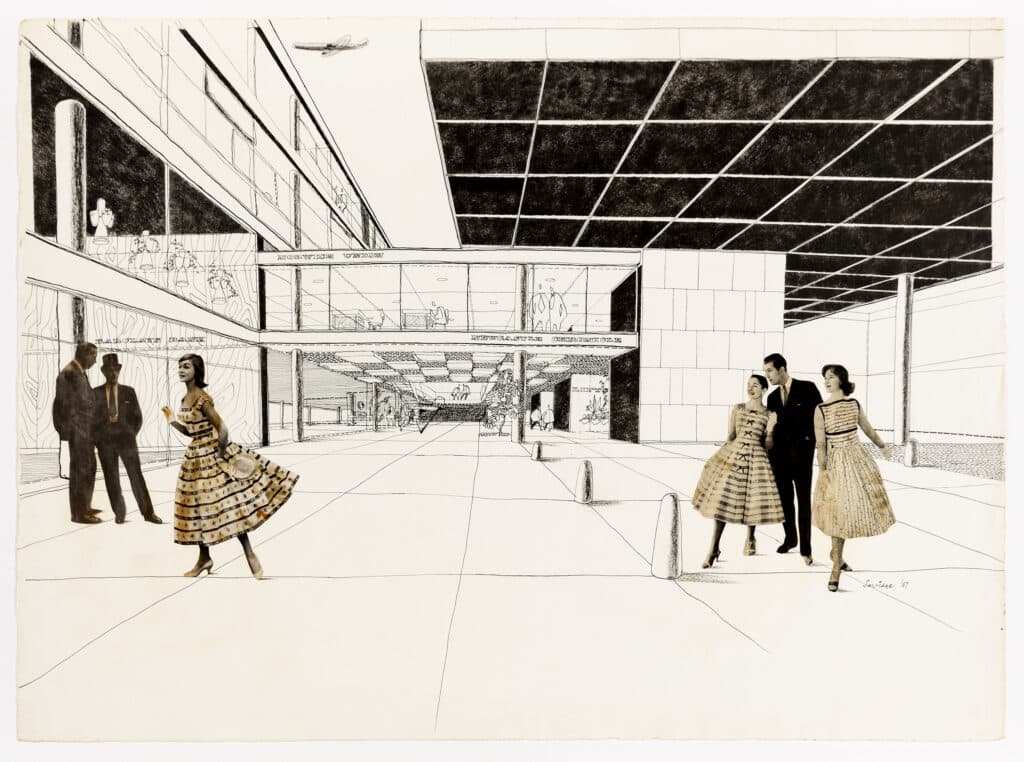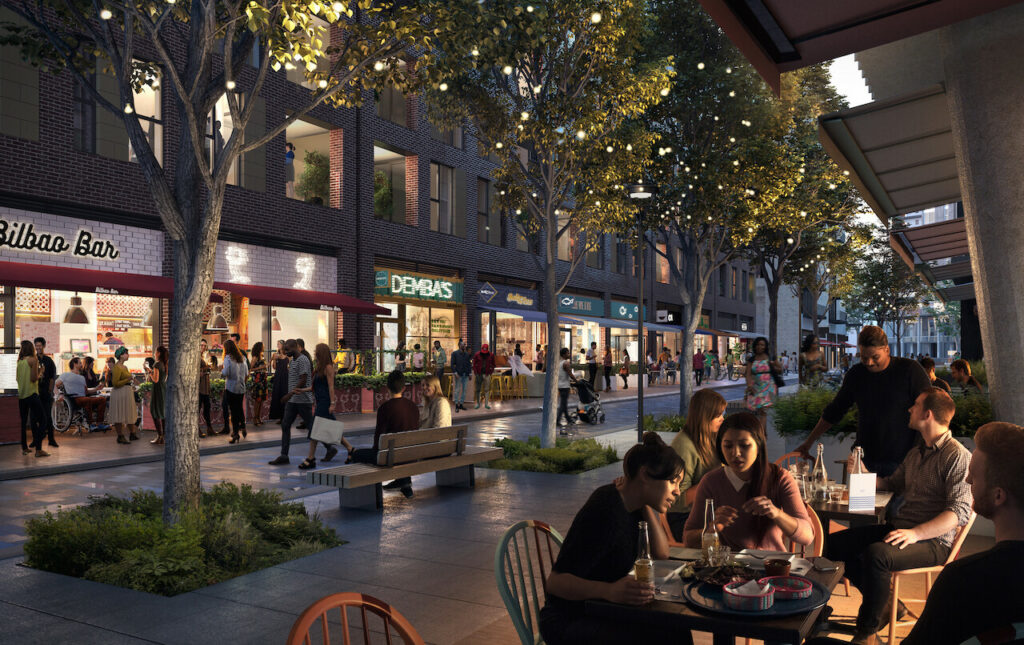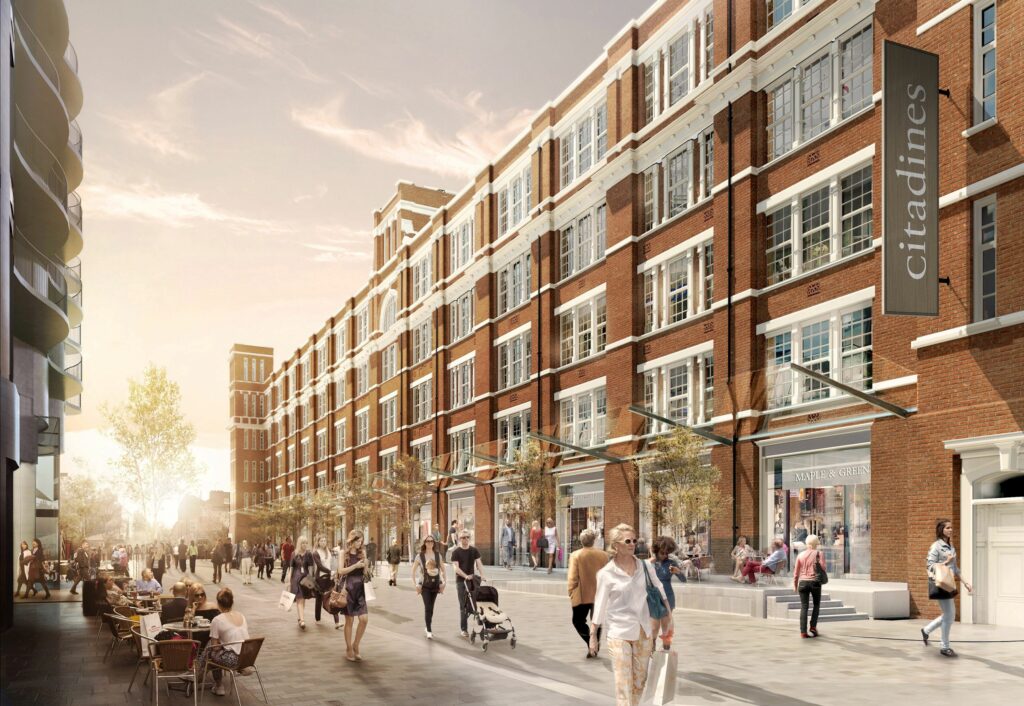Make me Hyper-Real: Image Ethics and the Architectural Visualisation
Architectural visualisations sell us the image of a new reality. In depicting a building that is designed, rather than completed, they constitute a kind of spatial hypothesis: a temptation of a happier, wealthier, and more connected world. By constructing these fictions through the means of the image, they sell us the notion that the project it depicts will improve our lives for the better.
In these beguiling images, realistic images of people play a central role in convincing us of this proposition, more so than earlier means of representing people, such as the drawn figure. A drawing by Rex Savidge for a new civic building in Newcastle illustrates this condition. It is an unusual drawing because it features both drawn and collaged figures. [1] The latter seem jarring against their cold counterparts and the rest of the backdrop, yet they play a far more crucial role in animating the image. While the simple line figures’ purpose appears to be predominantly to indicate scale, the fashionable, leisurely attire of the pasted figures suggests the social aspiration of the project – as an emblem of post-war, municipal modernity. A commercial airliner zooms triumphantly above the scheme in agreement.
The use of people in this drawing suggests two interesting points relating to architectural image-making. The first is that realism is a useful means of convincing us of the future world that the image is trying to depict, humanising the image. The second is that this sleight of hand depends upon the logistical employment of the latest image technology: in this case, photographs of people circulated via magazine.
Drawn figures make no attempt to deceive us about their ancestry. Their black and white linework defines a clear boundary between reality and the human form. This makes it clear to us that they are merely abstractions, perhaps even inventions: a fictional placeholder for how we might imagine ourselves in that space. In the case of Savidge’s drawing, the collaged figures are also clearly abstracted: for all their vibrancy, it is still evident to the viewer that they have been cut out of a magazine and pasted in. As viewers, we know where we stand.

When we look forward to today’s architectural image-making industry, however, we are no longer quite so sure of what we see. The evolution of rendering and post-production software has granted digital artists increasing control over the manipulation of their source material. Lighting, colour and even clothing or accessories can be added, removed, or transformed at will in order to assimilate people into the scene. This careful process of inclusion and exclusion defines who is and is not part of this future reality, manifesting the political agendas that lie behind the image. Subject to these complex forces, the people onto whose images these alchemies are performed begin to blend seamlessly into the image, so much so that we begin to forget that they have been implanted in the first place. Amidst the chaos, the images of these people have become something beyond their original subjects: they have become ‘hyper-real’.
The development of the hyper-real person raises urgent questions regarding the ethics of architectural image-making. How were these images extracted from life, and did these people grant their consent to the photographer who captured them? Were they paid for their image? Were they even aware that their image has been taken in the first place, let alone that it has been used to generate profit?
An eerie silence surrounds architectural visualisation companies. Their renders, each of which can sell for thousands of pounds, are dependent on the careful deployment of human bodies, but clarity about the very real people who own these bodies (who appear to have so graciously lent them to these companies) is absent from their shimmering portfolios. Much of the image-making industry relies on this process of quiet exploitation, fuelled by the knowledge that they will not be held to account by those whose images they use, nor by clients, who in the absence of discussion maintain the expedient assumption that they are ‘ethically sourced’.
Hyper-real people are extracted, then, and technology plays a crucial role in enabling this process. But how does this take place, and what is at stake? We might explore these, and previous questions, by constructing our own kind of fiction.
* * *
‘He watches her, gingerly, from across the street: a perfect subject for capturing. She’s coming at the perfect three quarter angle and there’s great lighting on her skin – shame about the shopping bag, but they could cut that out later.
He’s shooting from one of his usual spots. It was a good place to take photos because of the monument at the end of the road. As you pointed the camera at these unknowing pedestrians you could pretend you were just a tourist who was trying to get a holiday snap. It was better that way – you got them in their most candid state, which always made for the best renders – and for the most part you got away with it without suspicion. The few seconds in which they occupied the territory of your viewfinder were brief enough that the charade was plausible: only the shopkeepers and hawkers on the road, guardians of the street sphere, were there long enough to catch on to what you were doing. If they complained, you could simply move to the next spot: a perfect set-up.
As she nears, muscle memory takes over. He points his body at the monument, as usual, and tilts his camera down a little bit, and to the left.
Click, click, click!

‘She looked up from her half-empty Corona in disbelief. This wasn’t Paris. A second ago she was walking down the Champs-Élysées with her boyfriend, and now, somehow, she’s having dinner outside a tepid-looking Mexican restaurant with an equally-confused stranger. In fact, everyone in the surprisingly diverse crowd on the street seemed bewildered, as if they had been suddenly teleported from different corners of the world. Only the guy with the camera in front of her appeared relaxed.’ Text for illustrative purposes only.
An inoffensive, calculated rhythm of shots captures her image from a number of slightly different angles. It was best to take several photos, he’d been told, to make sure you always got them in focus.
An hour later, and with his morning’s work concluded, this covert, digital facsimile, amongst the hundreds of others who have been extracted from the streets, is brought back to the studio and prepared for implantation. In Photoshop, he readies his brush and traces her outline, carefully erasing the context which once bound her to a real place, leaving her suspended in checkered space. She’s now nothing more than a figure, of a certain size, shape, and race, wearing particular clothes in particular colours. She could be anywhere. Tracing is time-consuming, the runt-job of the office, to be done by interns, or those who are waiting for new projects to be allocated. So it’s done as efficiently as possible – after all, she might not be used in the end. She’s placed in a folder, dubiously named ‘ethnic people’, where she remains for a number of years, strangely ageless in her electronic tomb.
* * *
One day, it’s opened: a double-click blows her image up double size for inspection. They’re doing some views for a sensitive development and need some figures to help the project be more ‘on brand’ – residents have already accused the client of gentrification and they’re keen to avoid any further criticism. In a mark-up of one of their draft views, the client’s big red circle highlights the central park area. ‘Diverse people here’, it says.
Some seconds are spent deliberating whether she is the right solution for the image. Does the lighting match naturally; how sharp is the picture? And what about her clothes – maybe they’re a bit too ‘urban’ for this shot? Of course, he can change all of these things if he needs to, but it’s easier if there’s less work to do.
She is deployed.
In this image, she is placed on the grassy knoll in the foreground. The brown Primark carrier bag she is carrying is rubbed away and replaced with a Chanel handbag. This isn’t that kind of neighbourhood. A dash of light, supposedly for contrast, lightens her skin. The smile on her face, whose original target has been lost, is now directed at a pair of children, conceivably hers, playing nearby. She seems content, delighted at the safety of this new development, and grateful for the many retail opportunities it has so kindly brought her.
Her new neighbours appear similarly relaxed: they, too have been anxiously hurried out in the latest mark-up to dilute its overwhelming flavour of vanilla-suburb. She looks at them, immobile in this frozen frame, and wonders what they are thinking. Where were they, before they were here? Did they know they were being captured?
The artist makes a few more edits, changing the colour of her top to match the façade and lightening her hair: she now fits. Satisfied, he moves on to the next person.’
* * *
While this particular story is fictional, the condition it describes is very real. A widespread, extractivist culture drives the image-making industry, especially within the realm of high-end residential and hospitality developments. For the most part, visualisers and clients only perpetuate this practice: it is cheaper and easier to follow the past of least resistance, to maintain the specious assumption that an image of a person is an ethically neutral entity. But the industry’s complicity is not only in its silence: the methods relating to the unethical taking and manipulation of images of people are taught as standard practice within visualisation companies, who, from my own experiences of the industry, show a willing disregard for the agency of their figures.
A large number of articles across the sphere of architectural journalism rightfully decry the lack of representation within visualisations, but surprisingly few go on to ask about the very real people whose images are used within them, and the ramifications of unethical drawing practice . In producing ‘hyper-real’ people, the industry dehumanises the people on whose images it depends. Their digital transformation, which severs them from their context, and the taking of their image in the first place, which is so often done non-consensually, strips away their agency and removes them from the conversation that the image claims to facilitate. This process of production is problematic in and of itself, but is especially so as it often wields specific groups, such as wheelchair users and people of colour – particularly those who are Black or South Asian – to construct a defensive wall of ‘inclusivity’ around the image, to attempt to convince stakeholders and communities that the project will serve everyone equally. This form of tokenism is especially challenging as these extracted images, for which compensation is almost never provided, prove so profitable for visualisers and their clients. When accused, the expedient defence of current practice has been to mutter vagueries about representation and consider that that suffices. ‘You should be grateful to see yourself at all’, says its subtext. But the very real need to improve representation within architectural visualisations, and within the architecture industry in general, cannot found itself on the theft and exploitation of those on whose images it relies. If our calls for better representation are genuine, let them also be accompanied by consent, consideration and remuneration.

She strides triumphantly along the boulevard, bathed in the heavenly light which graces the streetscape. If only all of London was this beautiful. Like the many affluent, artsy types who find themselves following in her footsteps, offending clothes or colours have been bleached from her outfit. Ever the loyal customer, she carries a shopping bag bearing the development’s insignia – they could thank her later. It suited her anyway; in this street, the weather is always fair, and its people happy and wealthy. Text for illustrative purposes only.
The problems that extend from current practice demand a change in culture. How can we call for greater accountability from visualisers and their clients when the process of architectural image-making is so opaque? What will it take for consent not to be regarded as optional, and how can we call for more collaborative, democratic conversations to take place? Visualisers bear much of the localised responsibility for the state of current practice, but few appear committed to taking image consent seriously.
The creation and enforcement of regulations might provide one way of achieving this. Currently, there is limited professional representation of Architectural visualisers in the UK, [2] and among the organisations which do exist there is currently little guidance on ethical practice regarding human figure. In the absence of such checks and balances on visualisers and clients, the metric of ‘value’ is allowed to steamroll the conversation. A number of laws already exist around the use of image rights, especially for commercial purposes, and the introduction of a regulator could help to enforce these more rigorously, as well as to make them more stringent. They might do so by providing inspections on visualisation companies and requiring that they demonstrate ethical practice in order to achieve certification.
There may also be more creative ways of evidencing consent: for example, if we were to initiate a practice of footnoting people in a drawing, in the same way that we might do for a citation in a book:
‘W. Jones, photo taken 2013, Southwark. Reference number DS30032’
Such a practice would essentially be a form of meta-data certification. A regulator – or any interested party – could check the reference number against a database and assess the changes that have been made from the source file. Not only would this allow them to monitor for dubious practices such as whitewashing, and other instances of misuse, but it would also make it harder for visualisers to use images which have not been taken consensually. A royalties-based system – whose use already has precedent in a number of other industries – could ensure payment is consistently and fairly distributed.
Approaches such as this might help to ameliorate some of the erasure caused by the severance of a person from their original context. By maintaining a clear, traceable link between the image and the person whom it depicts, we destabilise the mesmerising hyper-reality of the image, making it harder for visualisers and clients to fall into the convenient habit of ignoring their agency.
There are also opportunities for important conversations within education: not only in university courses which relate to visualisation, but also perhaps even earlier, such as at school. The problematics surrounding image consent and data privacy cannot be excluded from curricula, especially those in which images of people are so central. If our skills are formed around these principles, rather than in spite of them, it will be easier for us to stay on track. For this, and any of the above opportunities to be meaningful, however, they must come as part of a broader shift in the relationship held between artists, architects, and designers, and the people who are involved by their projects.
Within the architectural visualisation, people are essential to our fictions. This word, fiction, has its roots in the latin fingere, meaning to mould, or shape. Such a process of shaping carries immense political power, and if we are to maintain that architectural visualisations, and the fictions they weave, constitute useful contributions to the construction industry and to society at large, we must hold ourselves accountable for the methods by which they are produced.
A change in habit can become an act of care. Thinking critically about who is disenfranchised by current systems of image production can help to pave the way towards more equitable forms of practice.
Notes
- Philippa Lewis’s brilliant and amusing piece, Behind The Lines, speculates on the reasons for this inconsistency.
- The closest thing to a professional body for UK visualisers is the Society of Architectural Illustrators, a professional organisation which promotes ‘the knowledge and appreciation of architectural illustration’. See https://www.sai.org.uk/about-the-sai/. A number of international organisations and associations also exist in Australia, Canada, Japan, Korea, the Philippines, Spain, and the USA, amongst others. One of the youngest, the Architectural Visualization Association, has run a number of promising events relating to industry issues since its inception. See http://archvizassociation.org/en/.

– Niall Hobhouse and Nicholas Olsberg